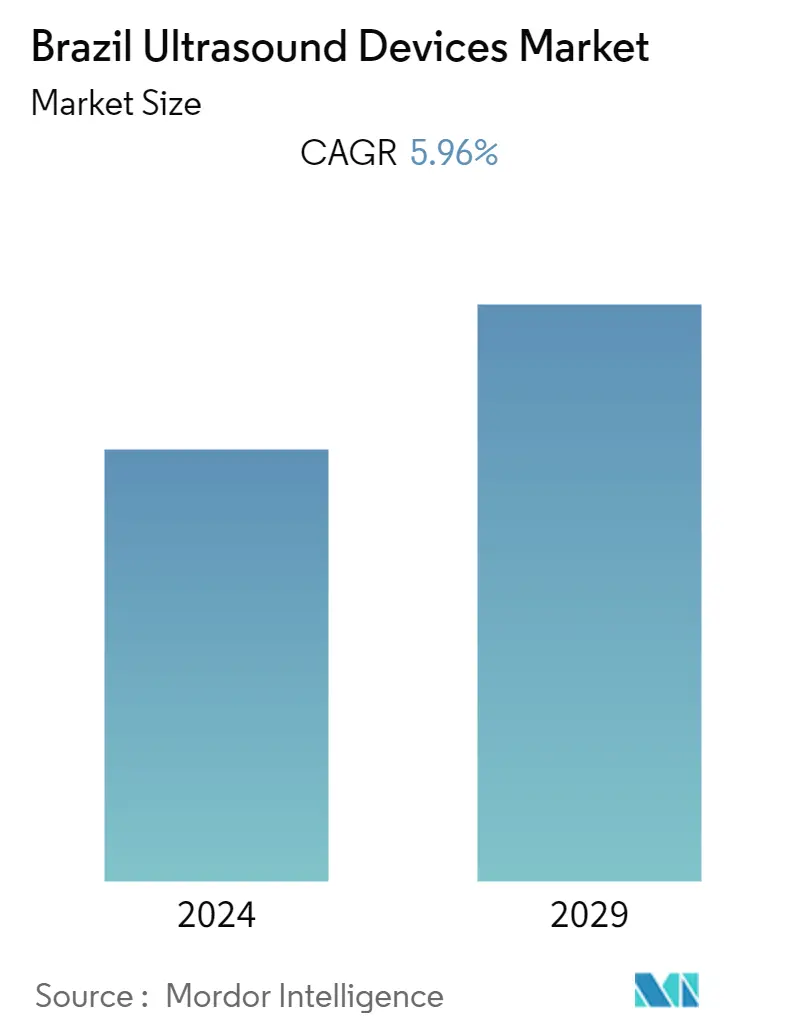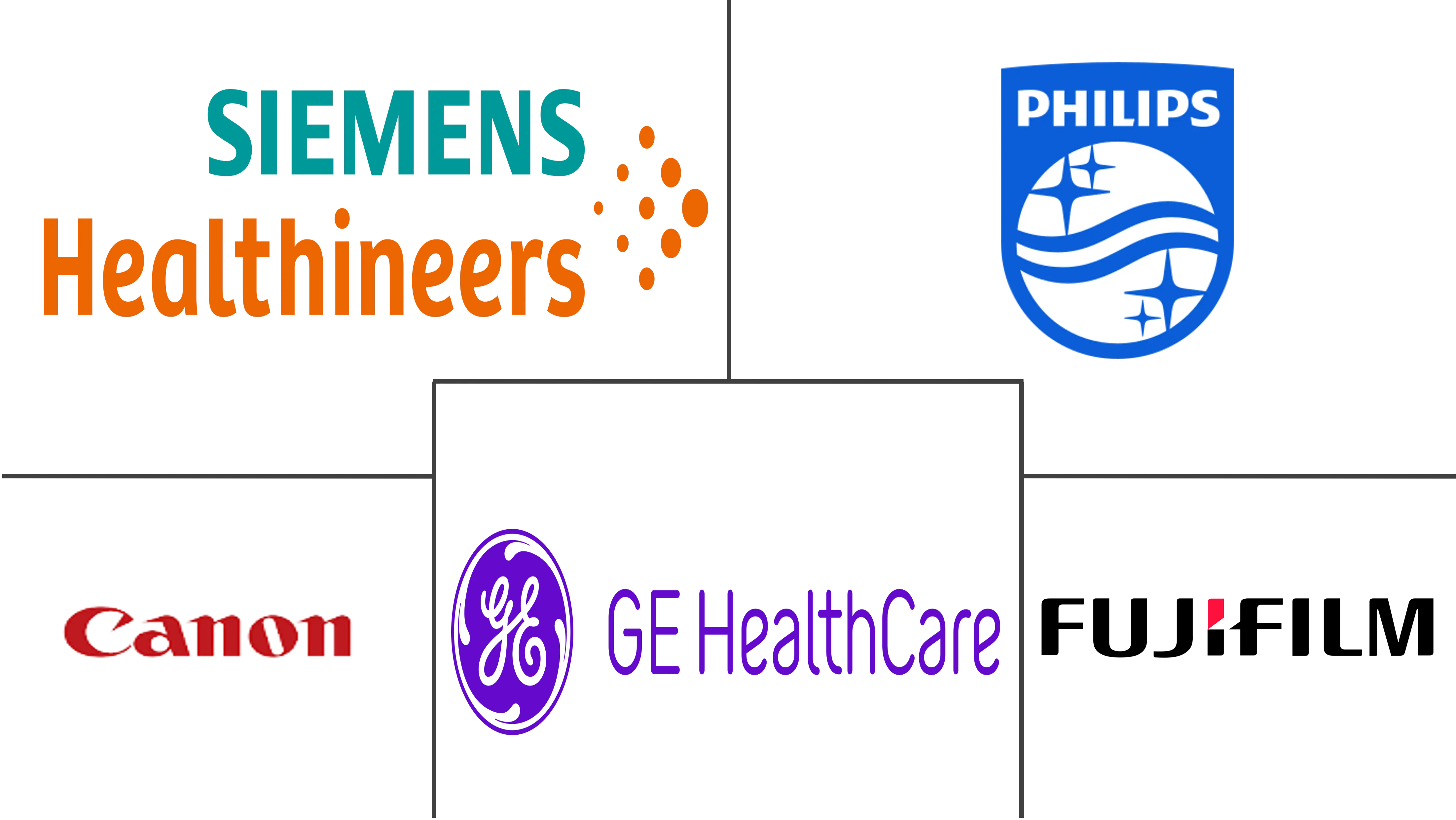Market Size of Brazil Ultrasound Devices Industry

| Study Period | 2019 - 2029 |
| Base Year For Estimation | 2023 |
| Forecast Data Period | 2024 - 2029 |
| Historical Data Period | 2019 - 2022 |
| CAGR | 5.96 % |
| Market Concentration | Medium |
Major Players
*Disclaimer: Major Players sorted in no particular order |
Brazil Ultrasound Devices Market Analysis
The Brazil Ultrasound Devices Market size is estimated at USD 176.66 million in 2023, and is expected to reach USD 235.97 million by 2028, growing at a CAGR of 5.96% during the forecast period.
The COVID-19 pandemic initially impacted the Brazil ultrasound devices market, with the decrease in the volume of ultrasound diagnoses that use ultrasound devices. For instance, according to a study published in the Health Policy and Technology in March 2023, the COVID-19 pandemic disrupted the diagnostic imaging examinations, including ultrasonography, in the Brazilian unified healthcare system. Although, in the post-pandemic period, the number of COVID-19 patients decreased in Brazil, which led to the resumption of the ultrasound diagnosis of non-COVID and non-urgent medical cases. Thus, the pandemic had a slight negative impact on the Brazil ultrasound devices market initially. However, the resumption of ultrasound diagnosis for other diseases enabled the market to grow at a normal pace with the increasing demand for ultrasound devices in Brazil.
The market is expected to grow with the increasing incidence of chronic diseases, improving healthcare infrastructure and programs. The country has a rising burden of chronic diseases, which is expected to create a higher demand for ultrasound devices to diagnose highly prevalent chronic diseases. For instance, according to a study published in Diabetology & Metabolic Syndrome in January 2022, one in every two one in two adults with Type 2 diabetes is associated with cardiovascular disease in Brazil. Also, as per the same source, the prevalence of all CVD subtypes was high in adults having the two diabetes-affected adults, except for carotid artery disease. Further, as per the data published by the International Agency for Research on Cancer (IARC) in 2023, the new cancer cases in Brazil are expected to increase in the coming years, with over 687 thousand cancer cases by 2025 to about 787 thousand cases by 2030. Thus, with such a high prevalence of chronic diseases, the demand for ultrasound devices will increase for the sonographic examination of these diseases, which will boost the market's growth in the coming years.
Furthermore, improving healthcare infrastructure and healthcare programs will increase the rate of diagnosis of patients, which will increase the volume of ultrasonography examinations in the country and bolster the demand for ultrasound devices in Brazil. For instance, in March 2023, Brazil's federal government launched its new Mais Médicos para o Brazil program, which will offer over 15,000 new vacancies in 2023, preferably to Brazilian physicians trained in Brazil, with the investment of BRL 712 million (USD 150.5 million) in 2023. Further, in October 2022, Rio de Janeiro launched a public consultation for a public-private partnership project to expand the Souza Aguiar hospital, with an investment of BRL 746 million reais (USD 145 million) in Brazil.
Therefore, owing to the rising burden of chronic diseases and the technological advancements in ultrasound devices, the studied market is anticipated to grow over the analysis period. However, strict regulations are likely to impede the market growth.
Brazil Ultrasound Devices Industry Segmentation
As per the scope of the report, a diagnostic ultrasound, also known as sonography, is an imaging technique that uses high-frequency sound waves to produce images of the different structures inside the body. They are being utilized for the assessment of various conditions in the kidney, liver, and other abdominal conditions. They are also majorly used in chronic diseases, which include health conditions such as heart disease, asthma, cancer, and diabetes. Therefore, these devices are being utilized as both diagnostic imaging and therapeutic modality and have a wide range of applications in the medical field. Brazil Ultrasound Devices Market is Segmented by Application (Anesthesiology, Cardiology, Gynecology/Obstetrics, Radiology, and Other Applications), Technology (2D Ultrasound Imaging, 3D and 4D Ultrasound Imaging, and Other Technologies), Type (Stationary Ultrasound and Portable Ultrasound). The report offers the value (in USD million) for the above segments. The report offers the value (in USD million) for the above segments.
| By Application | |
| Anesthesiology | |
| Cardiology | |
| Gynecology/Obstetrics | |
| Radiology | |
| Other Applications |
| By Technology | |
| 2D Ultrasound Imaging | |
| 3D and 4D Ultrasound Imaging |
| By Type | |
| Stationary Ultrasound | |
| Portable Ultrasound |
Brazil Ultrasound Devices Market Size Summary
The Brazil ultrasound devices market is poised for growth, driven by the increasing incidence of chronic diseases and advancements in healthcare infrastructure. The market experienced an initial setback due to the COVID-19 pandemic, which disrupted diagnostic imaging examinations, including ultrasonography. However, the resumption of ultrasound diagnoses for non-COVID and non-urgent medical cases has allowed the market to recover and grow steadily. The rising burden of chronic diseases, such as cardiovascular conditions and cancer, is expected to fuel the demand for ultrasound devices, as these technologies are crucial for diagnosing prevalent health issues. Additionally, government initiatives and investments in healthcare programs, such as the Mais Médicos para o Brazil program, are set to enhance diagnostic capabilities, further boosting the market's expansion.
The radiology segment of the ultrasound devices market in Brazil is anticipated to witness significant growth due to the increasing number of interventional procedures and the high prevalence of cancer and neurological diseases. The demand for ultrasound imaging is expected to rise, driven by the need for effective diagnosis and treatment planning. Technological advancements in 3D and 4D ultrasound imaging are also contributing to market growth, with research highlighting their efficacy in diagnosing fetal anomalies and assessing pain in fetuses. The market is characterized by a few key players, including Siemens Healthineers AG, Koninklijke Philips NV, GE Healthcare, Canon Medical Systems Corporation, and Fujifilm Holdings Corporation, who are actively involved in expanding their presence and offerings in Brazil.
Brazil Ultrasound Devices Market Size - Table of Contents
-
1. MARKET DYNAMICS
-
1.1 Market Overview
-
1.2 Market Drivers
-
1.2.1 Increasing Incidences of Chronic Diseases
-
1.2.2 Improving Healthcare Infrastructure and Healthcare Programs
-
-
1.3 Market Restraints
-
1.3.1 Stringent Regulatory Policies
-
-
1.4 Porter's Five Forces Analysis
-
1.4.1 Threat of New Entrants
-
1.4.2 Bargaining Power of Buyers/Consumers
-
1.4.3 Bargaining Power of Suppliers
-
1.4.4 Threat of Substitute Products
-
1.4.5 Intensity of Competitive Rivalry
-
-
-
2. MARKET SEGMENTATION (Market Size by Value - USD million)
-
2.1 By Application
-
2.1.1 Anesthesiology
-
2.1.2 Cardiology
-
2.1.3 Gynecology/Obstetrics
-
2.1.4 Radiology
-
2.1.5 Other Applications
-
-
2.2 By Technology
-
2.2.1 2D Ultrasound Imaging
-
2.2.2 3D and 4D Ultrasound Imaging
-
-
2.3 By Type
-
2.3.1 Stationary Ultrasound
-
2.3.2 Portable Ultrasound
-
-
Brazil Ultrasound Devices Market Size FAQs
What is the current Brazil Ultrasound Devices Market size?
The Brazil Ultrasound Devices Market is projected to register a CAGR of 5.96% during the forecast period (2024-2029)
Who are the key players in Brazil Ultrasound Devices Market?
Siemens Healthineers AG, Koninklijke Philips NV, GE Healthcare, Canon Medical Systems Corporation and Fujifilm Holdings Corporation are the major companies operating in the Brazil Ultrasound Devices Market.

